Thursday, March 6, 2014
Naranjilla
Solanum quitoensis ( Naranjilla )
A straggly shrub, reaching a maximum size of 10 x 7 feet, that is native to South America, north to Costa Rica. It is most common in southern Columbia, Ecuador and Peru. Naranjilla plants are usually not spiny, except for clones originating in the mountains of Costa Rica which are spiny. They are rapid growing if given an abundance of fertilizer once a month. They prefer tropical highland climates with 60 + inches of rainfall in a year and average monthly temperatures from 63 to 66 F throughout the year. The Naranjilla does not like temperatures above 85 F and prefers light or partial shade on humus-rich, fertile, well drained soil though tolerating stony soil as well. They prefer a site where there are large trees to protect them from excessive wind but not close enough to compete with the roots.
The large, angular-lobed leaves, up to 20 inches in length, are bright green and sometimes tinted purple. The leaves and the stems are densely fine hairy.
It is grown for its attractive foliage outdoors during summer or in greenhouses in temperate climates but will not fruit there.
The fragrant, white flowers, up to 1.2 inches across, are borne in clusters.
They are followed by fruits, up to 1.5 ( 2.5 inches in spiny Costa Rica form ) inches across, that resemble the related Tomato. The fruits have leathery, orange skin and green flesh. The juicy, tasty ( lemony-pineapple tasting ) fruits can be eaten but only after the brown hairy coat is washed off and the calyx removed ( the calyx will usually naturally separate when ripened ). The fruit from commercially grown plants is usually harvested before fully ripened so that they last longer during shipping.
Fruiting begins at about 10 months of age when grown from seed. The Naranjilla will continue to bear fruit until 4 to 7 years of age depending upon growing conditions.
Healthy plants bear a maximum of 150 fruits in a year, typically closer to 100.
Everbearing in ideal climates, in Florida they mostly bear fruit only in winter.
Fruits picked when half ripened will store for about 8 days at normal room temperature, up to 2 months refridgerated at 45 F with approx. 80% humidity.
The fruit have many flat, hard seeds up to 0.12 inches across.
Hardy zones 10 to 12. For commercial production it is recommended to plant the Naranjulla in rows so that they are 6 to 8 feet apart. In the tropics it is recommended to plant them in their permanent position during a cloudy day at the start of the rainy season. In monsoon climates with a distinct dry season, irrigation to crops is essential during the dry season.
* photos taken on Aug 20 2011 @ Brookside Gardens, Wheaton, MD


* photo taken on Aug 25 2011 @ Scott Arboretum, Swarthmore, PA

Read More..
A straggly shrub, reaching a maximum size of 10 x 7 feet, that is native to South America, north to Costa Rica. It is most common in southern Columbia, Ecuador and Peru. Naranjilla plants are usually not spiny, except for clones originating in the mountains of Costa Rica which are spiny. They are rapid growing if given an abundance of fertilizer once a month. They prefer tropical highland climates with 60 + inches of rainfall in a year and average monthly temperatures from 63 to 66 F throughout the year. The Naranjilla does not like temperatures above 85 F and prefers light or partial shade on humus-rich, fertile, well drained soil though tolerating stony soil as well. They prefer a site where there are large trees to protect them from excessive wind but not close enough to compete with the roots.
The large, angular-lobed leaves, up to 20 inches in length, are bright green and sometimes tinted purple. The leaves and the stems are densely fine hairy.
It is grown for its attractive foliage outdoors during summer or in greenhouses in temperate climates but will not fruit there.
The fragrant, white flowers, up to 1.2 inches across, are borne in clusters.
They are followed by fruits, up to 1.5 ( 2.5 inches in spiny Costa Rica form ) inches across, that resemble the related Tomato. The fruits have leathery, orange skin and green flesh. The juicy, tasty ( lemony-pineapple tasting ) fruits can be eaten but only after the brown hairy coat is washed off and the calyx removed ( the calyx will usually naturally separate when ripened ). The fruit from commercially grown plants is usually harvested before fully ripened so that they last longer during shipping.
Fruiting begins at about 10 months of age when grown from seed. The Naranjilla will continue to bear fruit until 4 to 7 years of age depending upon growing conditions.
Healthy plants bear a maximum of 150 fruits in a year, typically closer to 100.
Everbearing in ideal climates, in Florida they mostly bear fruit only in winter.
Fruits picked when half ripened will store for about 8 days at normal room temperature, up to 2 months refridgerated at 45 F with approx. 80% humidity.
The fruit have many flat, hard seeds up to 0.12 inches across.
Hardy zones 10 to 12. For commercial production it is recommended to plant the Naranjulla in rows so that they are 6 to 8 feet apart. In the tropics it is recommended to plant them in their permanent position during a cloudy day at the start of the rainy season. In monsoon climates with a distinct dry season, irrigation to crops is essential during the dry season.
* photos taken on Aug 20 2011 @ Brookside Gardens, Wheaton, MD


* photo taken on Aug 25 2011 @ Scott Arboretum, Swarthmore, PA

Garden Bloggers Bloom Day October 2011

 |
Montgomery Globe Spruce, Hosta and Grasses The reason I am a gardener is because the garden is constantly changing and there is always something to look forward to. As we walk along the perennial garden the once green foliage of the hosta has turned to amber and the grasses display their delicate wispy plumes against the blue of the Montgomery Spruce in the backdrop. |
 |
| Salvia Maynight and Visitor A busy bumblebee gathers pollen from the last of the salvia. |
 |
Sedum Brilliant The Sedum Brilliant has turned from bright pink to orange which is a nice touch for fall. |
 |
Stachys (Lambs Ear) After pruning off the spent flowers of the Lambs Ear its soft white foliage has rejuvenated which adds interest to the perennial bed border. In the backdrop the brilliant golds and reds from the Gold Flame Spirea shine through. |
 |
Perennial Garden in fall Here is a combination of grasses, hosta, astilbe and lambs ear along with Montgomery Blue Spruce, Spirea and Blue Star Juniper. It is really starting to look Fall-like. |
 |
Hosta Flower and Spirea Gold Flame A lone hosta flower emerges in front of the Gold Flame Spirea in the garden. |
 |
Heuchera Caramel The Heuchera Caramel is showing a display of new fall foliage. Caramel is a new addition to my garden this year and is definitely a favorite! |
 |
Crape Myrtle in fall The flower of the Crape Myrtle is done for the season but the beauty of this tree continues as it produces perfectly shaped seed pods on its branches. The Crape Myrtle keeps its leaves longer than most other trees and soon they will be a vibrant fiery red. |
 |
Weeping Blue Atlas Cedar, Rosy Glow Barberry, Gold Mop Cypress This section of the garden has a blend of of gold, crimson and blue. The arching branches of the Weeping Blue Atlas Cedar are really starting to cascade like a waterfall over the Gold Mop Cypress. |
 |
Dwarf Fountain Grass Hameln Here is a close up of a Hameln fountain grass plume...so delicate. The ornamental grasses really make October a time to look forward to. They are so whimsical in the garden. |
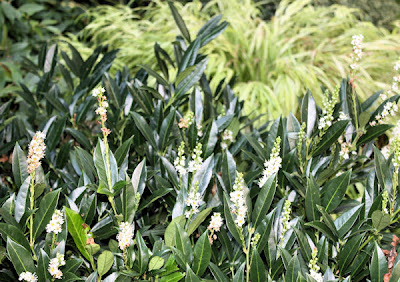 |
Cherry Laurel and Hakonechloa Grass The rain and mild weather here has sparked some blooms on the Cherry Laurel for an unexpected surprise. |
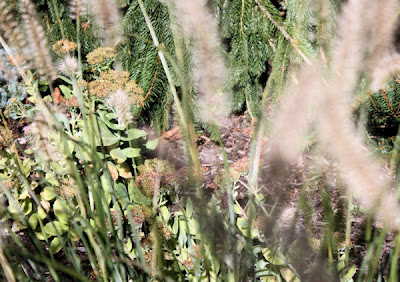 |
Fall Color: Grasses, Sedum and Weeping Norway Spruce More fun with macros with my camera. This is a close up of grasses and sedum in front of a Weeping Norway Spruce. |
 |
Weeping Birch in Fall The Weeping Birch (Betula pendula Youngii) has a delicate weeping habit and its white bark adds interest in all seasons. This one is already going into fall mode but the branches will display a nice framework in winter. |
 |
Blue Star Juniper, Heuchera and Sedum Here are blue star juniper, sedum and heuchera. This garden is visible from my outside patio and there are subtle changes each day as the seasons change. |
 |
Hydrangea Endless Summer Last but not least is the Endless Summer Hydrangea. There are many varieties and each one has its own uniqueness. The blooms even look nice well into the fall. They surely add a highlight to this gardeners day! |
I hope you have enjoyed the tour of my garden and will come back to visit. Thank you for stopping by and please be sure to visit our hostess Carol at May Dreams Gardens who has made Garden Bloggers Bloom Day possible on the 15th of every month throughout the year. I am also thrilled to be celebrating my 50th blog post on this wonderful Garden Bloggers Bloom Day!
Happy GBBD and Happy Gardening!
Winter is an etching, spring a watercolor, summer an oil painting and autumn a mosaic of them all."- Stanley Horowitz
Author:Lee@ A Guide To Northeastern Gardening Copyright 2011. All Rights Reserved

Subscribe to:
Comments (Atom)












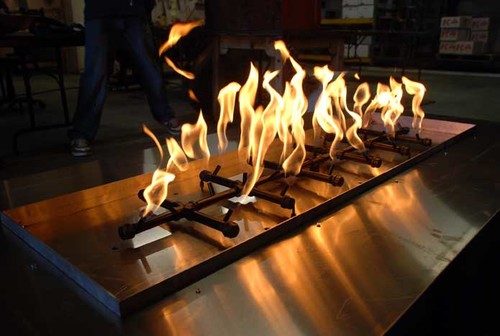

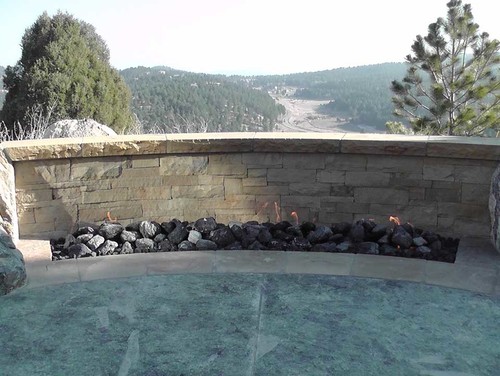








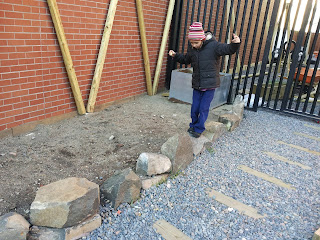















 www.landscapingnetwork.com This small backyard was redesigned to fit landscape walls, a pond, raised vegetable gardens, a metal patio cover and ...
www.landscapingnetwork.com This small backyard was redesigned to fit landscape walls, a pond, raised vegetable gardens, a metal patio cover and ...